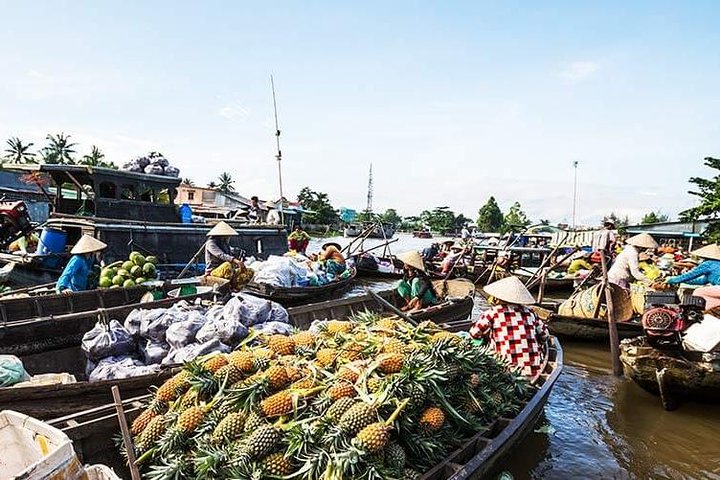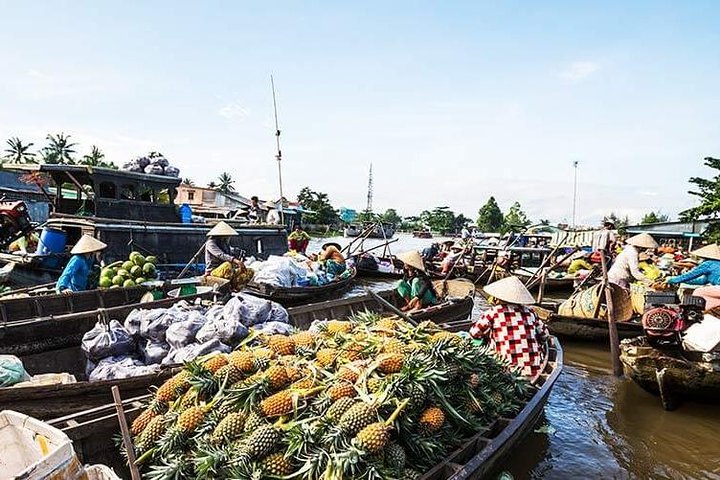Embark on a luxury group tour in Ho Chi Minh City and explore historic sites, learn traditional crafts, visit museums, admire colonial architecture, and immerse yourself in the lively local atmosphere.
Embark on a luxury group tour in Ho Chi Minh City and explore historic sites, learn traditional crafts, visit museums, admire colonial architecture, and immerse yourself in the lively local atmosphere.
-
Saigon Opera House (Ho Chi Minh Municipal Theater) - Standing magnificently at the heart of Saigon is the Saigon Opera House, which is also known as the Municipal Theater. The building stands as one of the impressive sight in Saigon – both night and day.
Saigon Opera House was built in 1898 by the French architect – Eugene Ferret, following the…
-
Saigon Opera House (Ho Chi Minh Municipal Theater) - Standing magnificently at the heart of Saigon is the Saigon Opera House, which is also known as the Municipal Theater. The building stands as one of the impressive sight in Saigon – both night and day.
Saigon Opera House was built in 1898 by the French architect – Eugene Ferret, following the “flamboyant” style of the French Third Republic. It was set to be two meters higher than the street surface with two door layers, in order to prevent traffic noise.
Located on the city’s center axis, connecting the metro station and roundabout in front of Ben Thanh market. From a distance, the Opera House looks like a beautiful gigantic city gate. The architecture boasts stone-carved ornaments and statues at the entrance, crystal chandeliers, and shiny granite floor at the lobby area – all built with materials imported from France. The graceful oval auditorium offers 468 seats, designed to magnify performances in both audio and visual, echo-free, and also soundproof from the outside city buzz. - Central Post Office - The city’s landmark French-era post office is a period classic, designed by Marie-Alfred Foulhoux (though often credited to Gustave Eiffel) and built between 1886 and 1891. A mosaic of Ho Chi Minh takes pride of place at the end of its barrel-vaulted hall.
The post office features a unique, bright yellow exterior framed with white trim. Curved windows are elegantly framed with green shutters and a large clock is featured prominently at the building’s main entrance. The stunning, spacious interior has tall, domed ceilings with metal arches and a gorgeous patterned tile floor. There are two painted maps inside the office – Lignes télégraphiques du Sud Vietnamet du Cambodge 1892 (Telegraphic lines of southern Vietnam and Cambodia 1892) depicts the postal route from southern Vietnam to Cambodia, and on the right side of the building is Saigon et ses environs, 1892 (Saigon and its surroundings), a local map.
- Emperor Jade Pagoda - Built in 1909 in honour of the supreme Jade Emperor (King of Heaven), this is one of the most atmospheric temples in Ho Chi Minh City, stuffed with statues of phantasmal divinities and grotesque heroes.
The pungent smoke of incense fills the air, obscuring the exquisite woodcarvings. Its roof is encrusted with elaborate tile work, and the temple’s statues, depicting characters from both Buddhist and Taoist lore, are made from reinforced papier mâché.
The multifaith nature of the temple is echoed in the shrine’s alternative name Phuoc Hai Tu, whose message is clearly Buddhist. Similarly, the Chinese character in the main temple hall mean ‘The light of Buddha shines on all.
Over 100 years old went by with many changes, Jade Emperor Pagoda remains the timeless charm. Its beauty is a harmonious combination among 3 main religions in the Orient: Taoism, Buddha, and Confucianism.
Thanks to the impressive & unique beauty with sacred legend, this is one of the most wonderful destinations.
- Sơn mài Đại Việt - The lacquer itself is actually the resin of a tree which is mixed with coloured pigments and solvents and applied layer after layer to the object’s surface, producing a shiny and durable finish. Eggshell and mother of pearl may be applied to the surface before the lacquer is applied, in which the finished product is sanded down to reveal the decoration beneath.
The high quality of resin from Vietnamese lacquer trees, notably those of Phu Tho, was a crucial factor in the rapid development of this art form during the feudal period.
Decorated lacquer statues, panels, boxes and trays (1428-1527), may still be seen at many temples and pagodas.
In subsequent centuries the use of lacquerware was extended to larger items such as wooden chairs and tables.
Since that time lacquerware has continued to develop into one of the mainstays of the Vietnamese handicraft industry, both at home and abroad. Today’s most popular items include vases, jewel cases, desk sets, trays and vertical blinds.
- War Remnants Museum - Founded on September 4, 1975, The War Remnants Museum is a member of the International Network of Museums for Peace (INMP) and the International Council of Museums (ICOM).
It is the unique museum in Vietnam to systematically study, collect, conserve and display exhibits on war crimes and consequences inflicted on the Vietnamese people by foreign aggressive forces. Simultaneously, the Museum appeals to everybody to oppose unjust wars, preserve global peace, promote friendship and solidarity among nations.
The Museum is endowed with 9 permanent thematic exhibitions and various special collections. All year round, a wide range of activities are organized, including conferences, meetings with war witnesses, temporary and itinerant exhibitions. With nearly one million domestic and international visitors per year, The War Remnants Museum is one of Ho Chi Minh City’s most enticing cultural and tourist sites.
-
Reunification Palace. Hcmc. Vietnam - Surrounded by royal palm trees, the dissonant 1960s architecture of this landmark government building and the eerie ambience of its deserted halls make it an intriguing spectacle. The first Communist tanks to arrive in Saigon rumbled here on 30 April 1975 and it’s as if time has stood still since then. The building is deeply associated with the fall of the city in 1975, yet it’s the kitsch detailing and period motifs that steal the show. It’s also known as the Independence Palace.
The building was named Independence Palace and was home to the succeeding South Vietnamese president, Nguyen Van Thieu, until his hasty departure in 1975. Designed by Paris-trained Vietnamese architect Ngo Viet Thu, it is an outstanding example of 1960s architecture, with an airy and open atmosphere.
The Reunification Palace, also known as Independence Palace, is a landmark building located in the heart of Ho Chi Minh City. And it is known as a must see National Monument once you are in Ho Chi Minh City.

- Travel insurance coverage up to $5,000 USD
- Complimentary bottled water
- Guided tour with an English-speaking guide
- All entrance fees included
- Air-conditioned transportation
- 24/7 hotline support
- Travel insurance coverage up to $5,000 USD
- Complimentary bottled water
- Guided tour with an English-speaking guide
- All entrance fees included
- Air-conditioned transportation
- 24/7 hotline support
- Tips/ gratuities
- Personal expenses
- Tips/ gratuities
- Personal expenses
• Museum of War Relics
• Explore the colonial designs of Notre Dame Cathedral
• Historic cultural landmarks of Ho Chi Minh City
• In-depth tour of the ancient Reunification Palace
• Journey to the historic General Post Office from the 18th century
• Experience the bustling environment of the local marketplace and venture into hidden alleys
• Tour of a…
• Museum of War Relics
• Explore the colonial designs of Notre Dame Cathedral
• Historic cultural landmarks of Ho Chi Minh City
• In-depth tour of the ancient Reunification Palace
• Journey to the historic General Post Office from the 18th century
• Experience the bustling environment of the local marketplace and venture into hidden alleys
• Tour of a classic assortment of military gear
• Discover the process of crafting traditional Vietnamese lacquerware artworks
• Take in the architectural grandeur of the Colonial-era
For a full refund, cancel at least 24 hours before the scheduled departure time.
For a full refund, cancel at least 24 hours before the scheduled departure time.

















